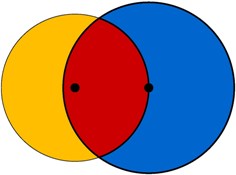A Farmer keeps a cow inside a circular fenced-in pen. The ground of the pen is covered in grass. To keep the cow from eating all of the grass at one time the farmer attaches a leash to the cow that is then attached to the fence of the circular pen. The question is: What length should the leash be such that the cow eats exactly one-half of the grass in the pen?
It should be obvious that the leash cannot be equal to the radius of the pen. In that case, the cow would eat less than half the grass. It turns out the answer is not as straight forward as one might think and actually requires some numerical analysis to get the result.
The image displayed to the right,top shows the geometry of the situation. The red represents the intersection of the two circles. The smaller (yellow) circle represents the boundary of the fence. The radius of the larger circle (blue) represents the "leash" of the cow. The goal is to determine the the radius of the blue circle such that the red intersection area is equal to the yellow section of the smaller circle.
Click on image to see the solution to this problem.
